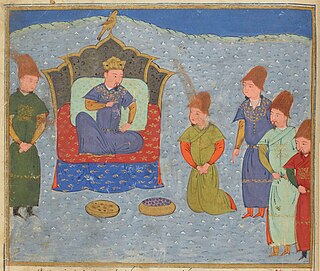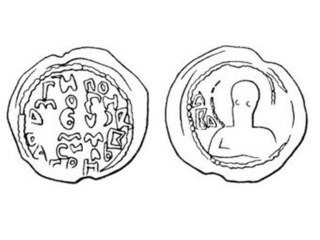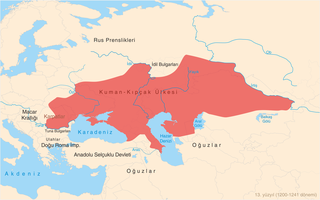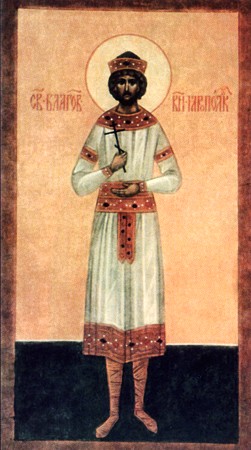Related Research Articles

Vsevolod I Yaroslavich was Grand Prince of Kiev from 1078 until his death.

The Mongol Empire invaded and conquered much of Kievan Rus' in the mid-13th century, sacking numerous cities including the largest such as Kiev and Chernigov. The Mongol siege and sack of Kiev in 1240 is generally held to mark the end of Kievan Rus' as a distinct, singular polity. Many other Rus' principalities and urban centres in the northwest and southwest escaped destruction or suffered little to no damage from the Mongol invasion, including Galicia-Volhynia, Novgorod, Pskov, Smolensk, Polotsk, Vitebsk, and probably Rostov and Uglich.

Batu Khan was a Mongol ruler and founder of the Golden Horde, a constituent of the Mongol Empire. Batu was a son of Jochi, thus a grandson of Genghis Khan. His ulus ruled over the Kievan Rus', Volga Bulgaria, Cumania, and the Caucasus for around 250 years.

Vladimir II Monomakh was Grand Prince of Kiev from 1113 to 1125. He is considered a saint in the Eastern Orthodox Church and is celebrated on May 6.

The Kipchaks or Qipchaks, also known as Kipchak Turks or Polovtsians, were Turkic nomads and then a confederation that existed in the Middle Ages inhabiting parts of the Eurasian Steppe.

The Cumans or Kumans were a Turkic nomadic people from Central Asia comprising the western branch of the Cuman–Kipchak confederation who spoke the Cuman language. They are referred to as Polovtsy in Rus', Cumans in Western and Kipchaks in Eastern sources.

The name Cumania originated as the Latin exonym for the Cuman–Kipchak confederation, which was a tribal confederation in the western part of the Eurasian Steppe, between the 10th and 13th centuries. The confederation was dominated by two Turkic nomadic tribes: the Cumans and the Kipchaks. Cumania was known in Islamic sources as Dasht-e Qebchaq, which means "Steppe of the Kipchaks"; or "Kipchak Plains", in Persian and al-Qumāniyīn in Arabic. Russian sources have referred to Cumania as the "Polovtsian Steppe", or the "Polovtsian Plain".
Sviatopolk II Iziaslavich was Grand Prince of Kiev for 20 years, from 1093 to 1113. He was not a popular prince, and his reign was marked by incessant rivalry with his cousin Vladimir Monomakh.
Yaroslav II Vsevolodovich, also transliterated as Iaroslav, was Grand Prince of Vladimir from 1238 to 1246. He helped to restore his country and capital after the Mongol invasion.

The Battle of the Kalka River was fought between the Mongol Empire, whose armies were led by Jebe and Subutai, and a coalition of several Rus' principalities, including Kiev and Galicia-Volhynia, and the Cumans under Köten. They were under the joint command of Mstislav the Bold and Mstislav III of Kiev. The battle was fought on May 31, 1223 on the banks of the Kalka River in present-day Donetsk Oblast, Ukraine, and ended in a decisive Mongol victory.
Oleg Svyatoslavich ; c. 1052 – 1 August 1115) was a Rus Sviatoslavichi prince whose equivocal adventures ignited political unrest in Kievan Rus' at the turn of the 11th and 12th centuries. He reigned as Prince of Chernigov from 1097 to 1115, and was the progenitor of the Olgovichi family.

The Battle of Didgori was fought between the armies of the Kingdom of Georgia and the Seljuk Empire at the narrow place of Didgori, 40 km west of Tbilisi, on August 12, 1121. The large Muslim army, under the command of Ilghazi, was unable to maneuver and suffered a devastating defeat due to King David IV of Georgia's effective military tactics.

Roman Mstislavich, also known as Roman the Great, was a Rus’ prince and a member of Izyaslavichi of Volhynia clan. He founded the Romanovichi dynasty, which would rule Volhynia and Halych until 1340.
The Cumans-Kipchaks in Georgia are of an ancient nomadic Turkic people who inhabited large territories from Central Asia to Eastern Europe. They played an important role in the history of many nations in the region, Georgia among them. At the height of this Caucasian power from the 12th to the 13th centuries, Georgian monarchs recruited thousands of Kipchak/Cuman mercenaries and successfully exploited their service against the neighboring Muslim states.

Köten was a Cuman–Kipchak chieftain (khan) and military commander active in the mid-13th century. He forged an important alliance with the Kievan Rus' against the Mongols but was ultimately defeated by them at the Kalka River in 1223. After the Mongol victory, Köten led 40,000 "huts" to Hungary, where he became an ally of the Hungarian king and accepted Catholicism, but was nonetheless assassinated by the Hungarian nobility.
Boniak, Bonyak or Maniac, also known as Boniak the Mangy, was "one of the most prominent Cuman chieftains" in the late 11th century and the early 12th century. He headed a powerful Cuman tribe or clan that inhabited the steppes to west of the Dnieper River. He supported the Byzantines against the Pechenegs in the Battle of Levounion in 1091. He defeated Coloman, King of Hungary in 1097 or 1099.

Yaropolk Iziaslavich or Yaropolk Iziaslavych was a Kniaz (prince) during the eleventh-century in the Kievan Rus' kingdom and was the King of Rus (1076–1087). The son of Grand Prince Iziaslav I of Kiev (Kyiv) by a Polish princess named Gertruda, he is visible in papal sources by the early 1070s but largely absent in contemporary Rus sources until his father's death in 1078. During his father's exile in the 1070s, Yaropolk can be found acting on his father's behalf in an attempt to gain the favor of the German emperors and the papal court of Pope Gregory VII. His father returned to Kiev in 1077 and Yaropolk followed.

The Council of Liubech was one of the best documented princely meetings in Kievan Rus' that took place in Liubech on October 19, 1097. The council ended the Chernihiv war of succession (1093–1097) between Sviatopolk II of Kiev, Vladimir II Monomakh and Oleg I of Chernigov who fought for the heritage of his father Sviatoslav II of Kiev.
Iaroslav Sviatopolkovich, also known as Iaroslav or Yaroslav Sviatopolchich, was Prince of Volhynia from 1100 to 1118.
References
- 1 2 3 Anatoly Michailovich Khazanov, André Wink (2001), Nomads in the Sedentary World, pp. 46-8. Routledge, ISBN 0-7007-1369-7.
- 1 2 Denis Sinor (1990), The Cambridge History of Early Inner Asia, pp. 181,280. Cambridge University Press, ISBN 0-521-24304-1.
- ↑ Gerard Chaliand (2003), Nomadic Empires: From Mongolia to the Danube, p. 52. Transaction Publishers, ISBN 0-7658-0062-4.